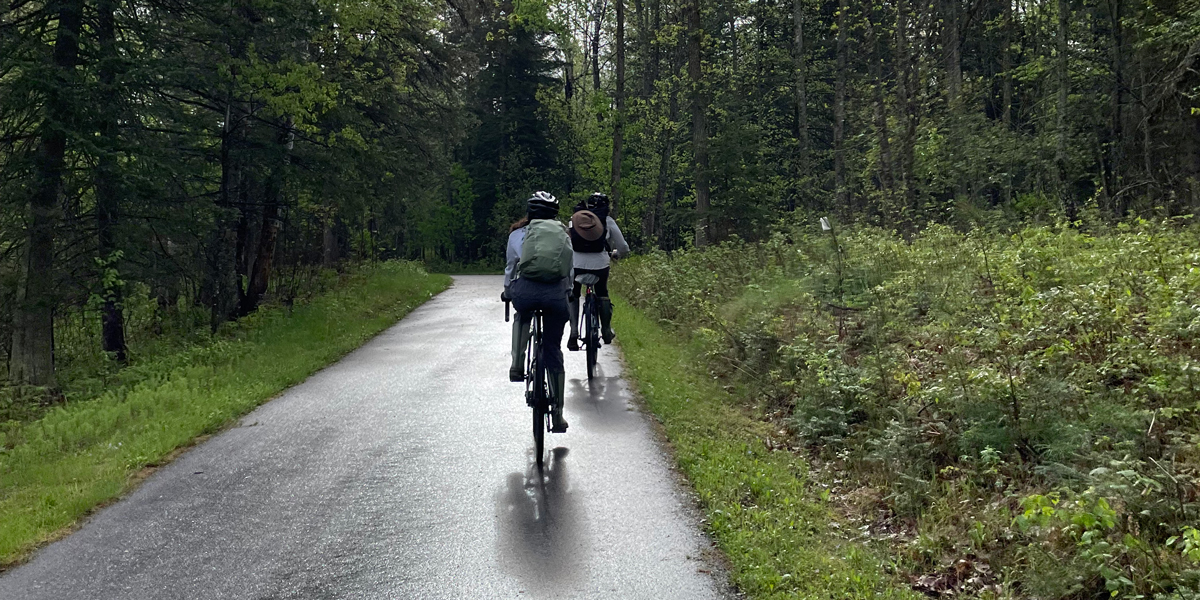
We sat our breakfast among a scatter of pencils, scrap paper, chunks of cross-sectioned bracket fungi, and tree mapping gear on our big kitchen table in cabin 3. Calipers (key to measuring plant stems), computers, compasses, pencils, notebooks, snacks, and more snacks slide into our backpacks. Stepping outside, I am grateful for the layers between me and the early morning chill. I add another layer, the linchpin: a mass of netting fashioned into a “bug jacket.” I zip it over my face. We buckle our helmets and step over the seat of our bikes, pushing off across campus.
As we wind up the bike path, I catch the rounded lobes of basswood leaves, the pinnate points of ash leaflets, and the occasional plume of white pine needles in my periphery. We turn off the bike path, plunging through thickets of ferns and struggling up “the big hill.” After pushing through a mess of muck riven by our previous passage, we arrive at our base camp, consisting of a bear-resistant cooler and fold out stools amid trampled vegetation. We unload our lunches, strap on fanny packs (blending function and fashion) and prepare for the trek across our plot of Northwoods.
As we follow each other between trees, across swamps, clambering over logs, we look up. Just two weeks ago, the sugar maples were draped in spring green chandeliers, the reds studded with rubies. Broad leaves have since unfurled across their canopies, casting emer - ald shade. In the four weeks we spend in our small patch of Northwoods, we watch buds break, leaves expand, the canopy fill, the flowering and wilting of a dozen wildflowers, the emergence of some of my favorite mushrooms. As we move through the plot tree by tree, we teach each other their names, patching together a portrait of an ecosystem.
By this time next year, each woody stem in our patch of woods that measures more than one cm across at my shoulder will have a “unique identifier.” The year after next, it will be identified to species, measured, and geolocated within a meter of its actual location (0.8 m + 0.3 m, to be exact. I calculated). And “patch of woods” is a bit mis - leading. Really, it’s roughly 40 acres. In total, we estimate that there are 35,000 stems in our plot. With a team of five including myself, a grad student, two undergrads, and two recently minted high school graduates from nearby Waubun (The Dream Team), we figured out how map the woods this summer, pinning down 3,000 stems in the process. It’s slow work, but it’s a start.
This extensively mapped patch of woods will one day be what my advisor Dr. Peter Kennedy likes to call, “a sandbox for other researchers.” We hope our mapping data will provide rich context for other scientists, encouraging them to contribute their research to our shared knowledge of the plot. This mosaic of information, combined with multiple tree censuses over the years, will enable us to track the response of Minnesota’s Northwoods to climate change. This reality is years away, however. For now, The Dream Team moves at a snail’s pace. We breathe in the fresh air, learn the names of the creatures around us, and collect knowledge stem by stem.
Talia Michaud is a Ph.D. candidate in the Plant and Microbial Biology program at the University of Minnesota. Her research is focused on fungal ecology and symbiosis.